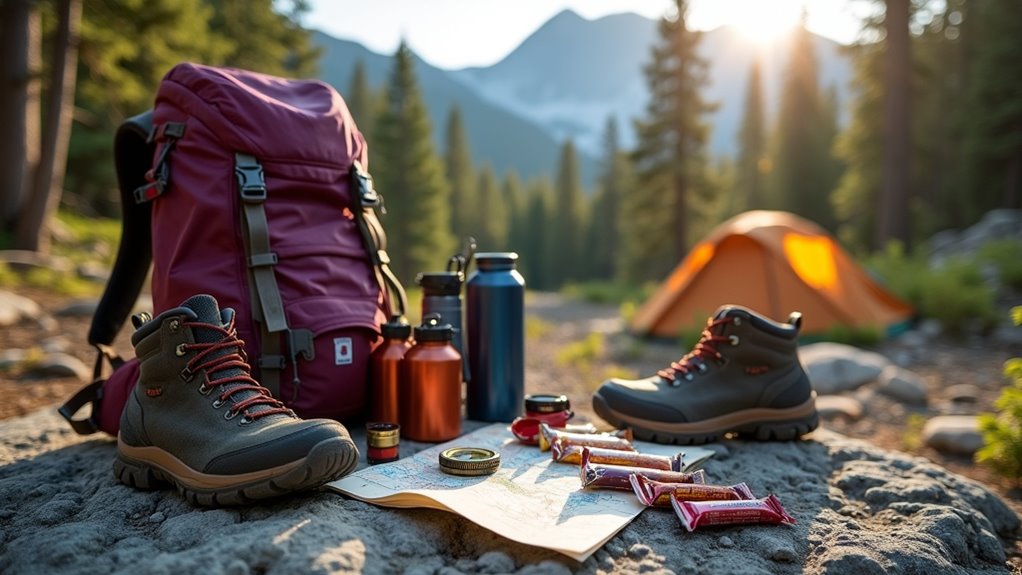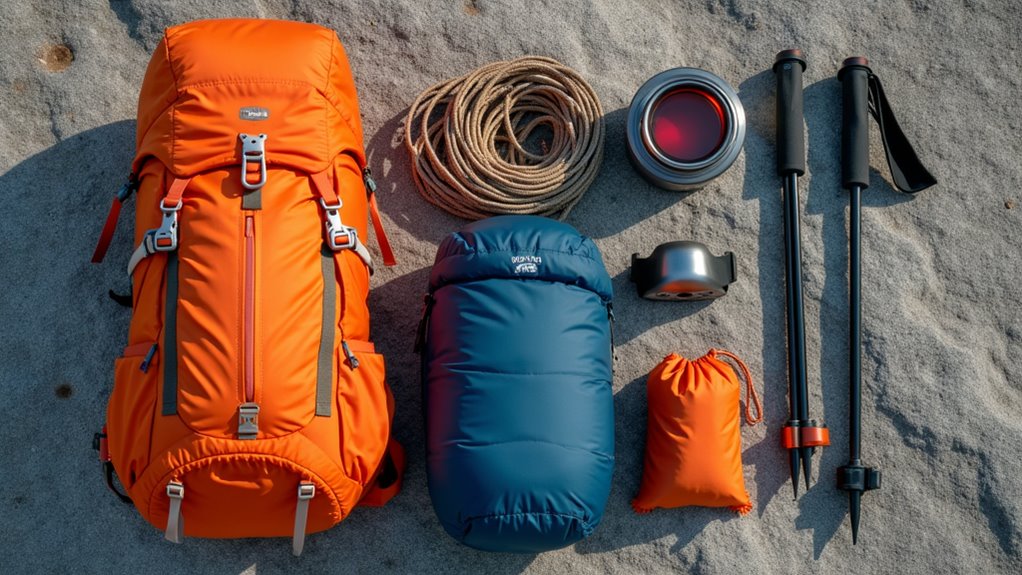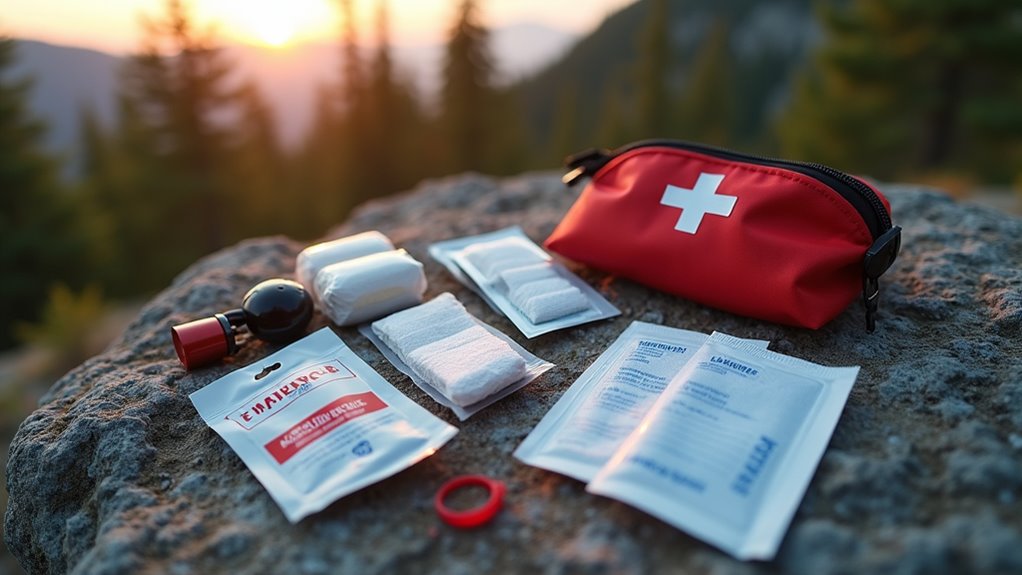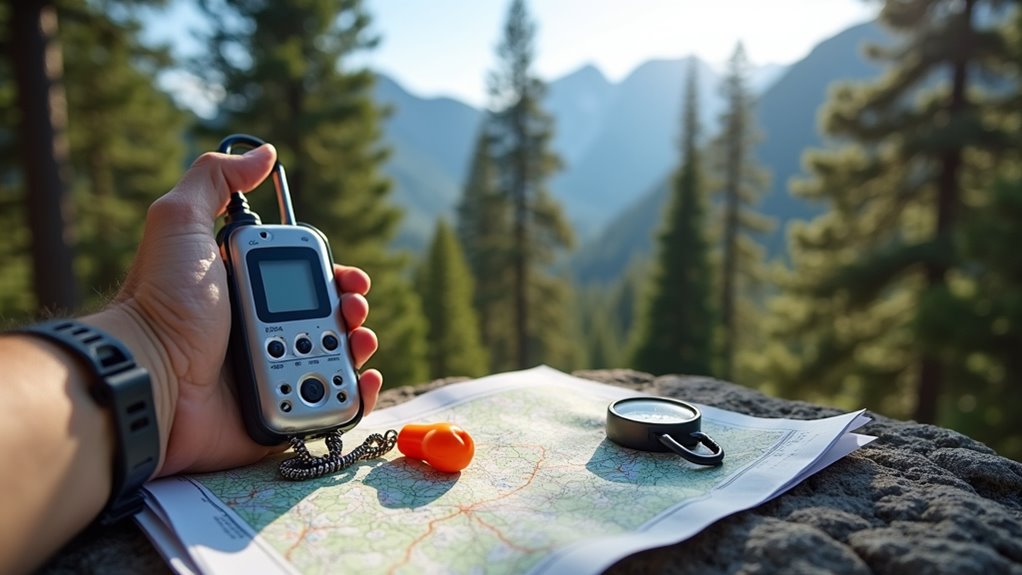Physical Address
304 North Cardinal St.
Dorchester Center, MA 02124
Physical Address
304 North Cardinal St.
Dorchester Center, MA 02124

Whether you're a novice or expert, these 12 overlooked hiking considerations could mean the difference between adventure and disaster.
You’re excited about your upcoming camping trip, but hiking adds layers of complexity you can’t ignore. Beyond throwing gear in a pack, you’ll need to contemplate everything from trail difficulty and weather patterns to wildlife encounters and emergency protocols. The difference between a memorable adventure and a dangerous situation often comes down to preparation details most campers overlook. These twelve critical considerations will determine whether you return home with great stories or costly mistakes.

When you’re planning a hiking trip that includes camping, your gear selection can make or break your outdoor experience. You’ll need a reliable backpack that distributes weight evenly and fits your torso length. Don’t skimp on footwear – invest in quality hiking boots that you’ve broken in beforehand.
Your shelter system should include a lightweight tent, sleeping bag rated for expected temperatures, and an insulating sleeping pad. Pack essential navigation tools like a map, compass, and GPS device.
You’ll also need a headlamp with extra batteries, first aid kit, and water purification tablets or filter.
Consider the weight of every item since you’ll carry everything on your back. Choose multi-purpose gear when possible, and test all equipment before your trip to avoid unpleasant surprises in the wilderness. With the overwhelming variety of options available, understanding the essentials of camping gear will help you make informed decisions and avoid unnecessary purchases.
Understanding weather patterns and seasonal changes will determine not only what gear you pack but also when and where you should plan your hiking adventures. Check weather forecasts at least three days before departure, but don’t rely solely on predictions—mountain weather changes rapidly.
Spring brings muddy trails and unpredictable temperatures. Summer offers longer daylight but increases heat exhaustion risks and thunderstorm potential. Fall delivers stunning views with cooler temperatures, though early snow’s possible at higher elevations. Winter hiking requires specialized gear and experience.
Research your destination’s seasonal patterns. Coastal areas stay milder while mountains experience extreme temperature swings. Pack layers regardless of season—you’ll shed or add clothing as conditions change. Always carry rain protection and emergency shelter, even on clear days. Remember that proper camping preparation includes considering these weather factors as part of your overall trip planning strategy.

Before you lace up your boots, you’ll need to honestly assess both the trail’s challenges and your own abilities. Don’t let enthusiasm override common sense – choosing the wrong trail can turn your camping adventure into a dangerous ordeal.
Start by researching trail ratings, elevation gain, and total distance. Most trails use a simple easy-moderate-difficult system, but dig deeper into specifics like terrain type and technical sections. Consider your group’s fitness level and hiking experience realistically.
Don’t let trail ratings fool you – dig deeper into terrain specifics and honestly evaluate your group’s actual hiking abilities.
Plan your route with multiple bailout points and alternative paths. Download offline maps and share your itinerary with someone reliable back home. Just as water activities have their inherent dangers, hiking presents its own set of risks that require careful preparation and awareness.
Even with the best route planning, you’ll find yourself lost without reliable navigation tools and backup systems. Your smartphone’s GPS is convenient, but don’t rely on it alone. Download offline maps before your trip since cell service disappears in remote areas.
Pack a physical topographic map and compass as your primary backup – they don’t need batteries or signal.
Consider a dedicated GPS device for extended backcountry hiking. These units offer longer battery life and better satellite reception than phones.
Always carry extra batteries or a portable charger.
Learn basic compass navigation before you leave. Practice triangulation and bearing techniques at home.
Mark key waypoints and escape routes on your map.
Tell someone your planned route and expected return time.
If you find yourself without a compass, you can still navigate using natural landmarks, the sun’s position, and stars to determine direction and stay on course.
Smart hikers prepare for navigation failures before they happen.

While navigation keeps you on track, finding safe drinking water becomes your most critical survival skill in the wilderness. You’ll need approximately one gallon per person daily, but carrying that much isn’t practical for longer hikes.
Identify reliable water sources like flowing streams, springs, and clear mountain lakes. Avoid stagnant pools, water downstream from animal activity, or sources with suspicious odors. Always treat water before drinking, even if it looks pristine.
Your purification options include:
Pack multiple purification methods as backups. When exploring glacier climbing trails, pristine mountain water sources may be more abundant but still require proper treatment before consumption.
After securing your water supply, you’ll need to fuel your body with the right foods to maintain energy throughout your hiking adventure. Pack lightweight, nutrient-dense foods that won’t spoil easily. Trail mix, energy bars, dried fruits, and nuts provide quick energy boosts.
For longer hikes, bring sandwiches with protein-rich fillings or instant oatmeal packets.
Calculate your caloric needs based on hiking intensity and duration. You’ll burn 300-500 calories per hour depending on terrain difficulty and your body weight. Plan to consume small portions every hour rather than waiting until you’re hungry or exhausted.
Fuel your hike with 300-500 calories hourly based on terrain difficulty and body weight to maintain steady energy levels.
Store food in waterproof containers or sealed bags to prevent moisture damage. Don’t forget electrolyte replacements through sports drinks or salt tablets to prevent cramping and maintain proper hydration balance. Remember to practice proper food storage techniques to keep wildlife away from your campsite and maintain a respectful outdoor environment.

Before you set foot on any trail, you’ll want to pack a thorough first aid kit and emergency supplies that could save your life or someone else’s. Don’t rely on basic bandages alone – wilderness injuries require specialized care. Pack blister treatment, pain relievers, antiseptic wipes, and emergency blankets.
You’ll also need a whistle, flashlight, and extra batteries.
Consider the terrain and weather conditions when selecting supplies. Rocky trails demand ankle support and wound care items, while cold climates require hypothermia prevention tools.
Your first aid kit should be easily accessible in your pack and contain items specifically chosen for the length and difficulty of your hiking adventure.
Since your comfort and safety depend heavily on what you wear, choosing the right footwear and clothing system becomes critical for any camping hike. You’ll want sturdy hiking boots with ankle support and proper tread for your terrain. Break them in before your trip to avoid blisters.
Layer your clothing strategically: start with moisture-wicking base layers, add insulating mid-layers like fleece, and top with a waterproof shell jacket. This system lets you adjust as conditions change. Avoid cotton fabrics that retain moisture and lose insulation when wet.
Pack extra socks and consider gaiters to keep debris out of your boots. Don’t forget a hat for sun protection and warmth. Your clothing choices can make the difference between an enjoyable hike and a miserable experience.
Following these backpacking tips will ensure you stay comfortable and prepared throughout your hiking adventure.

While you’re focused on enjoying nature’s beauty, understanding local wildlife behavior keeps you safe and protects the animals you encounter. Research the area beforehand to know which animals you might meet and their typical behaviors. Make noise while hiking to avoid surprising wildlife, especially in dense vegetation or around blind corners.
Store food properly in bear canisters or hang it high between trees. Never feed wildlife, as it creates dangerous dependencies and aggressive behavior.
If you’re planning to combine hiking with water activities, consider family-friendly rafting trips that offer controlled environments where guides can help manage wildlife encounters along riverbanks.
As you explore the wilderness, every step you take affects the delicate ecosystems around you. Following Leave No Trace principles protects these environments for future generations.
Plan ahead and travel on durable surfaces like established trails and rock slabs. Avoid trampling vegetation or creating new paths.
Stick to marked trails and rocky surfaces to minimize your environmental impact and preserve fragile plant life for others.
Dispose of waste properly by packing out all trash, leftover food, and toilet paper. Human waste should be buried 6-8 inches deep, 200 feet from water sources.
Leave what you find – don’t take rocks, plants, or artifacts. Minimize campfire impacts by using established fire rings and completely extinguishing fires.
Respect wildlife by observing from a distance and storing food securely. Keep noise levels down to preserve the natural soundscape.
Your responsible actions ensure pristine wilderness experiences for everyone. When planning winter camping trips, these principles become even more crucial as cold weather conditions can amplify environmental damage and make recovery slower.

Before you hit the trail, establishing a solid communication plan can mean the difference between a minor inconvenience and a life-threatening emergency. You’ll want to share your detailed itinerary with trusted contacts, including trailheads, campsites, and expected return times. Don’t rely solely on cell phones since coverage can be spotty in remote areas.
Consider these essential communication strategies:
Your communication plan isn’t paranoia—it’s responsible outdoor preparation. Just as adventurers planning Snake River rafting trips must consider communication needs for multi-day wilderness excursions, hikers should apply similar preparedness principles to backcountry camping.
Since your body will carry everything you need for days on the trail, building proper fitness becomes your foundation for an enjoyable camping adventure. Start preparing at least six weeks before your trip.
Your body becomes your pack mule on multi-day adventures, making physical preparation the cornerstone of trail success.
Focus on cardiovascular endurance through regular hiking, walking, or stair climbing with a loaded backpack. Gradually increase your pack weight to match what you’ll carry.
Strengthen your legs, core, and shoulders with squats, lunges, and planks. Don’t neglect your feet – break in your hiking boots during training walks to prevent blisters.
Practice hiking on varied terrain similar to your destination.
Build up your daily walking distance progressively. If you’re planning 10-mile days, work up to that distance during training.
Your muscles, joints, and cardiovascular system need time to adapt.
Just as you’d carefully weigh the decision between renting or buying outdoor equipment for your adventure, consider whether to rent or purchase specialized hiking gear before committing to expensive items you may only use occasionally.
You’re now equipped with the tools to transform your camping dreams into reality. Think of this preparation as planting seeds—each consideration you’ve made will bloom into confidence on the trail. Your backpack becomes a trusted companion, your knowledge a guiding star through uncertainty. Don’t let fear cast shadows on your adventure. You’ve built the foundation; now step forward and let the wilderness become your second home.